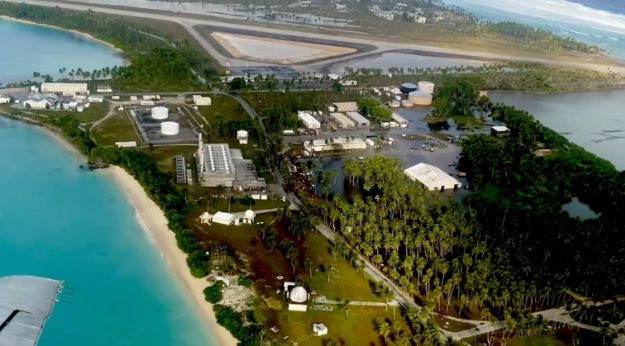The series of waves wreaked havoc on the island of Roi-Namur.
A series of extreme waves that wreaked havoc on a U.S. military base in the Marshall Islands could be indicative of more dangerous coastal behavior in the future, according to experts.
Flooding from the waves inundated one-third of the island of Roi-Namor, located in the Kwajalein Atoll in the northern Marshall Islands, according to the U.S. Army. The U.S. Army Garrison-Kwajalein Atoll base serves as a space and missile defense test range for the U.S. Department of Defense and contains some of the Army’s most sophisticated tracking equipment.
The waves did serious damage to several locations on the island, according to the U.S. Army. Ocean water had washed over the northwest side of the island. Standing water was found in several buildings on the base, such as the dining facility, the chapel and a theater, the Army said, citing an initial aerial damage assessment.
Joe Sienkiewicz, chief of the ocean applications branch for for NOAA’s Ocean Prediction Center, said this extreme wave was “much larger” than the average size of the waves hitting the island’s shores.
“If there are multiple wave sets, then it’s possible that the energy can just double in an area from two different sets of waves,” Sienkiewicz told ABC News.
With extreme waves, the height of a particular wave could be twice as high as other waves in the background, Sienkiewicz said.
It appears that multiple waves caused the damage to the island.
Cellphone video taken from the inside of a restaurant shows the force of a large wave forcing down the door of a restaurant on the Army base. Another wave is then seen rushing in, crashing through windows as patrons inside the restaurant attempt to take refuge on dining tables.
Sea level may have played a contributing factor into the severity of the waves and could cause them to occur more often in the future, Sienkiewicz said.
The Marshall Islands are considered at the very front lines of climate change, with research showing that rising sea levels contribute to powerful, destructive waves and more flooding in coastal areas as a result.
Several other factors, such as coastal topography, weather conditions and tide cycles, could have also played a role in the strength of the waves. Other causes could include a rapid change in the bathymetry, or the depth of the water, Sienkiewicz said.
Eighty people were evacuated from Roi-Namor. Sixty people remain to assess the damage and restore basic services, according to the Army. The top priorities are clearing the runway, U.S. Army Col. Drew Morgan said in a statement.
“Once the runway is open, we can move people and equipment back and forth to start the recovery process,” Morgan said.
The recovery event for the flooding is going to be a “marathon,” Morgan told ABC News.
Sienkiewicz warned people who go to the beach to be vigilant if they start to witness a wide variety in the size of waves.
“Just be cautious — cautious in a sense that don’t venture into the surf line or even close to the surf line,” he said.
